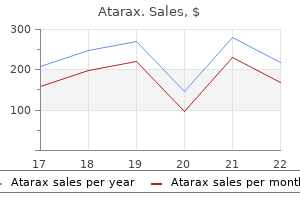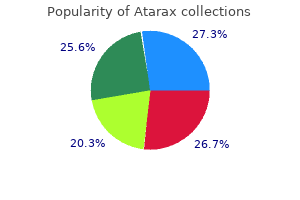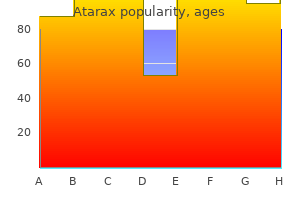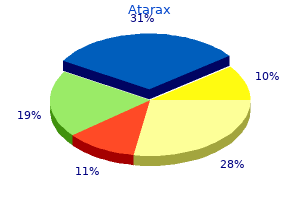Christopher Whaley PhD
- Assistant Adjunct Professor

https://publichealth.berkeley.edu/people/christopher-whaley/
It must be kept in mind anxiety 7 cups of tea buy genuine atarax on line, however anxiety in college students purchase 10 mg atarax otc, that the most worrisome emerging infectious disease may well be the one not yet recognized anxiety questions buy 25 mg atarax. Clinicians and public health officials today must remain vigilant for outbreaks of novel or unexplained diseases anxiety 504 plan buy genuine atarax online. For example, in May 2004, there was a large outbreak of avian influenza involving the H5N1 strain and human cases have been reported in two countries from this region. Thus far, no human-to-human transmission has been reported, but the potential for genetic reassortment between avian and human or animal strains of influenza exists. A recent report in the journal Science, linked the influenza virus responsible for the 1918 epidemic to a possible avian origin. If true, avian influenza may pose a much greater danger to human populations than previously reported. In vitro studies suggest the neuraminidase inhibitor class of drugs may have clinical efficacy for treating and preventing avian Influenza infection. Human Influenza: the threat for pandemic spread of human influenza viruses is substantial. Two distinct phenomena contribute to a renewed susceptibility to influenza infection among persons who have had influenza illness in the past. As few as four amino acid substitutions in any two antigenic sites can cause such a clinically significant variation. Influenza causes more than 30,000 deaths and more than 100,000 hospitalizations annually in the U. Pandemic influenza viruses have emerged regularly in 10to 50-year cycles for the last several centuries. The 1957-58 pandemic caused 66,000 excess deaths, and the 1968 pandemic caused 34,000 excess deaths in the U. The 1918 influenza pandemic illustrates a worst-case public health scenario: it caused 675,000 deaths in the U. Morbidity in most communities was between 25-40%, and case mortality rate 106 averaged 2. A re-emergent 1918-like influenza virus would have tremendous societal effects, even in the event that antiviral medications are effective against more lethal influenza virus. Death and desquamation of respiratory epithelial cells leads to inflammation and edema in the respiratory tract, with transient hyper-reactivity of the airway and consequent pulmonary dysfunction. While the virus is deposited in the respiratory tract, the signs and symptoms of influenza are systemic. The severity of flu symptoms can range from mild upper respiratory symptoms at one extreme, to fatal pneumonia on the other. Typical signs and symptoms in adults include an abrupt onset of fever (usually >100fiF) that peaks within 24 hours and persists for from 1 to 5 days, nonproductive cough, chills, headache, myalgia, sore throat, anorexia, and malaise. This factor may be useful in differentiating influenza infection from other common respiratory illnesses. Other symptoms may include substernal chest pain, photophobia, and gastrointestinal symptoms including nausea, abdominal pain, and diarrhea, (although these symptoms are rarely prominent). Hospitalization or death related to influenza arises primarily from its complications, especially from secondary bacterial pneumonia. The influenza virus may be isolated from respiratory tract specimens within 24 hours of the onset of illness. In general, viral shedding peaks at 3 to 5 days after exposure and is usually complete by 5 to 10 days. Typically, two Influenza A strains, and an Influenza B strain are selected for the trivalent influenza vaccine. In addition, vaccinating hospital and outpatient care employees can also minimize transmission to these individuals by infected caregivers. Influenza vaccine is recommended for women in the second or third trimesters of pregnancy during the flu season. Influenza vaccine is also 107 recommended for those at risk for coming into contact with avian influenza; although the avian strains are not covered by the vaccine, it may prevent coinfection with circulating human strains, and reduce the risk of genetic reassortment and emergence of novel strains. Through their action on the viral M2 protein, amantadine and rimantadine interfere with the replication of the type A virus. When administered within the first 48 hours of illness, either of these two agents improves time to recovery by 1 to 2 days. Amantadine is indicated for treating influenza in both children and adults; insufficient data have been accumulated to approve a pediatric indication for rimantadine. In addition to their therapeutic indications, both antiviral agents are also indicated to prevent the development of illness after exposure to type A viruses. The most significant safety issues associated with either amantadine or rimantadine involve the development of central nervous system side effects, such as nervousness, anxiety, lightheadedness, or impaired concentration. The frequency of these side effects is significantly greater in persons taking amantadine than in those taking rimantadine. Because transmissible viral resistance to amantadine or rimantadine can occur, it is appropriate to discontinue treatment after 3 to 5 days or within 24 to 48 hours after symptoms resolve. The infection quickly spread by travel to Hong Kong, and from there to Vietnam, Canada, and other locations. A case was initially defined by clinical criteria that included potential exposure to an existing case and fever with pneumonia or respiratory distress syndrome as a suspected or probable case. Laboratory tests may be helpful but do not reliably detect infection early during the illness. Treatment: While the use of ribavirin, high-dose corticosteroids, and interferons has been attempted, it is unclear what effect they have had on clinical outcome. Empiric antibiotic treatment for community acquired pneumonia by the current American 109 Thoracic Society/Infectious Diseases Society of America guidelines is recommended pending etiologic diagnosis. An antibody response can occasionally be detected during the first week of illness, is likely to be detected by the end of the second week of illness, and at times may not be detected until >28 days after onset of symptoms. Nipah and Hendra Viruses: They are closely related but distinct paramyxoviruses that comprise a new genus within the family Paramyxoviridae. The Nipah virus was discovered in Malaysia in 1999 during an outbreak of a zoonotic infection involving mostly pigs and some human cases. Hendra was identified in a similar outbreak involving a single infected horse and three human cases in Southern Australia in 1994. It is believed certain species of fruit bats are the natural hosts for these viruses and remain asymptomatic. The mode of transmission from animal to humans appears to require direct contact with tissues or body fluids, or with aerosols generated during butchering or culling. Personal protective equipment including gowns, gloves, respiratory, and eye protection is advised for agricultural workers culling infected animal herds. In symptomatic cases, the onset of disease begins with flu-like symptoms and rapidly progresses to encephalitis with disorientation, delirium, and coma. Fifty percent of those with clinically apparent infections have died from their disease. There is currently no approved treatment for these infections and therefore therapy relies heavily on supportive care. The antiviral drug, 110 ribavirin, has been used in past infections but its effectiveness remains unproven in clinically controlled studies. Although no person-person transmission is known to have occurred, barrier nursing and droplet precautions are recommended as respiratory secretions and other bodily fluids are known to harbor the virus. The clinical laboratory should be notified before sending specimens, as these may pose a laboratory hazard. Specimens for viral isolation and identification should be forwarded to a reference laboratory. Bioengineered Threats the rapid advance of biotechnology has tremendous potential to alter the present and future threat of biological weapons.

On histopathology anxiety symptoms 9dp5dt buy generic atarax 10mg, there is infamx-ray of the left upper extremity is shown in the mation of the subcutaneous fat anxiety symptoms 37 buy generic atarax, tissue septal image anxiety online test discount atarax 10 mg online. If left untreated anxiety feels like purchase line atarax, which of the following widening, neutrophilia, and fbrin exudation. A previously healthy 30-year-old woman who performs as a contortionist in the circus is found unconscious in her dressing room. An autopsy is performed and an abnormality is discovered in the circle of Willis, as shown in the image. Current proteins was most likely defective in this paDiagnosis & Treatment in Orthopedics, 4th ed. What aspect of epithelial cell junctions is targeted by (A) Fibrillin-1 autoantibodies in this conditionfi A couple brings their 3-year-old son to the emergency department, reporting that he fell down the stairs and broke his arm. The boy has a tearful face and gingerly holds his right arm by the elbow, but refuses to look the physician in the eye or to answer any questions. Which of the following types of fracture is most likely to suggest an etiology of child abusefi New York: plaining of red and itchy eyes for the past eight McGraw-Hill, 2008; Figure 327-1. The patient has had pain on urination and diffuse joint pain for 1 month, but tested negative for gonorrhea and chlamydial infec(A) Binds tubulin tion on a previous visit three weeks ago. A 57-year-old automotive factory worker with no signifcant past medical history reports to (A) Anklyosing spondylitis the clinic complaining of weakness and pain (B) Lyme arthritis in his right shoulder with any movement. He (C) Psoriatic arthritis says that for the past two weeks he has had (D) Reactive arthritis trouble lifting his right arm above his head. He (E) Systemic lupus erythematosus reports using his left arm to lift his right arm slightly, and then he can lift his right arm the 16. He lowing muscles is most likely injured in this has experienced intermittent acute attacks of patientfi Joint (D) Supraspinatus fuid is aspirated, and the fuid is examined (E) Teres minor under polarized light (shown in the image). A 22-year-old emergency room nurse has a positive purifed protein derivative test. She begins a nine-month prophylaxis regimen, but two months into treatment she complains of the sudden onset of fever, rash, and swelling of her joints. A 12-year-old African-American girl is brought His neurologic examination reveals a symmetto the physician with complaints of fever, malric smile, symmetric palate elevation, midline aise, and pain in her left forearm for the past tongue, as well as good shoulder shrug and four days. However, he has diftrauma or fracture, but recounts an upper resfculty opening his mouth and biting down piratory infection a few days ago. Damage to what cranial nerve could exhas been hospitalized three times for abdomiplain his conditionfi A 42-year-old woman comes to the clinic combecause of abnormal stature and growth. She states that for the child displays short stature, shortening of the past three weeks her eyes have been very dry proximal limbs, short fngers, and frontal bossand itchy, and she is unable to make tears. Physical examination reveals bilateral dry, ulcerated cor(A) Bone resorption neas and fssures on the sides of her lips. In (B) Collagen formation addition, both of her knees are erythematous (C) Endochondral ossifcation and swollen. An 18-year-old man is injured during a soccer game when the goalie dives for the ball but tackles the player on the lateral aspect of his leg. He is helped off the feld and brought to the emergency department, where he tells the physician that he heard a pop when he was tackled. The pain is located at the distal right (B) Increased serum 1,25-dihydroxycholecaltibia and has persisted over the past two weeks. On exlevel amination, the site is erythematous and swol(D) Increased serum calcium level len. A plain flm x-ray is taken, the results of (E) Increased serum phosphorus level which are shown in the image. A 45-year-old woman who recently underwent scant, clear cytoplasm and no evidence of nora left mastectomy and axillary dissection for mal bony matrix. Which of the following is the breast cancer now presents to her physician most likely diagnosisfi A 42-year-old woman has had increasing pain and swelling of the joints of her hands and feet for several months. A microscopic image of the synovium of a proximal interphalangeal joint in her hand is shown in the image. Jeevak Almast, University of Rochester Meditory serologic fndings would most likely be cal Center. A 1-year-old adopted, darkly pigmented boy is brought to the pediatrician for his frst wellchild check-up. A 27-year-old homeless man presents to the (B) Anti-nuclear antibody clinic because of a fve-day history of pain and (C) Borrelia burgdorferi antibody swelling in his right upper arm. A 6-year-old child is brought to the emergency Which of the following would a complete hisdepartment by his parents after they all retory of this patient most likely revealfi His parents report that approximately two weeks ago he had a fever and diarrhea that resolved. On further questioning, his parents state that he is home-schooled and that he has never received vaccinations. On physical examination he is unable to dorsifex (A) Corticosteroid use or evert at the ankle. In addition, the patient (B) Intravenous drug use reports pain and numbness in the lateral leg (C) Miliary tuberculosis and dorsum of the foot. When asked to walk, (D) Multiple sexual partners he raises his affected leg high off the ground (E) Sickle cell anemia and his foot slaps the ground when walking. A 22-year-old woman who is a professional tenfollowing structures is most likely to be comnis player presents to her physician because of promised by this fracturefi A 50-year-old man who recently returned from (A) Lengthening of A band; no change in H visiting family in northern New Mexico comes band; shortening of I band to the physician with exquisitely tender and (B) No change in A band; lengthening of H enlarged lymph nodes. He also complains of band; lengthening of I band fever, chills, and general weakness. On physi(C) No change in A band; shortening of H cal examination, the physician notes a painful band; shortening of I band ulcer surrounded by dark, hemorrhagic pur(D) Shortening of A band; no change in H pura on the right arm in the area where, acband; shortening of I band cording to the patient, a fea had bitten him (E) Shortening of A band; shortening of H fve days ago. After being admitted to the hosband; no change in I band pital, the patient soon develops abnormal coagulation times and is quickly started on a regi37. A 38-year-old man comes to the clinic with a men of streptomycin and tetracycline.

The performance characteristics that must be established include accuracy anxiety in teens atarax 25mg with amex, precision anxiety examples buy atarax 25mg fast delivery, reportable range anxiety symptoms twitching discount 10 mg atarax overnight delivery, reference interval anxiety treatment cheap atarax online mastercard, analytical sensitivity, and analytical specificity. Clinical laboratories are challenged to understand the requirements and determine the types of experiments and analyses necessary to meet the requirements. A variety of protocols and guidelines are available in various texts and documents. This review presents information that laboratories may consider in their efforts to meet regulatory requirements. Summary: In the setting of infectious disease emergencies, rapid and accurate identification of the causative agent is critical to optimizing antimicrobial therapy in a timely manner. However, for most small clinical laboratories, implementation of these advanced molecular techniques is not feasible owing to the high cost of instrumentation and reagents. Phenotypic methodologies (staining, cultures, biochemical tests, and serology) still play a critical role in identifying, confirming, and providing antibiotic susceptibility testing for many microbial pathogens. As multiplex assays become increasingly available, there will be even greater temptation for taking a "shotgun" approach to diagnostic testing. Section 5 and physical examination leading to a thoughtful differential diagnosis. None the less, these new molecular tests increase the capability of the diagnostician to rapidly identify the microbiological etiology of an infection. An added advantage of rapid diagnostic tests often not emphasized is the capability to rule out certain diagnoses for which unnecessary antimicrobial therapy may otherwise be instituted and/or continued. Summary: the superior sensitivity and specificity associated with the use of molecular assays has greatly improved the field of infectious disease diagnostics by providing clinicians with results that are both accurate and rapidly obtained. Herein, we review molecularly based infectious disease diagnostic tests that are Food and Drug Administration approved or cleared and commercially available in the United States as of December 31, 2010. We summarize indications for testing, limitations, and challenges related to implementation in a clinical laboratory setting for a wide variety of common pathogens. The information presented in this review will be particularly useful for laboratories that plan to implement or expand their molecular offerings in the near term. The special features of the herpesvirus life cycle include the ability to establish latent, nonproductive infection and the life-long capacity for reactivation to productive, lytic infection. Interactions between latent virus and the immune system determine the frequency and severity of symptomatic infections. The immunologic and cellular effects of herpesvirus infections contribute to risk for opportunistic infections and graft rejection. Among the most important advances in transplantation are laboratory assays for the diagnosis and monitoring of herpesvirus infections and antiviral agents with improved efficacy in prophylaxis and therapy. For herpes simplex virus, varicella zoster virus and cytomegalovirus, these advances have significantly reduced the morbidity of infection. Both commercial assays and assays developed in-house appear to be equivalent with regard to sensitivity and specificity. Additionally, the optimal specimen and amplified region may vary in different malignancies. Comparison of six different specimen types for Epstein-Barr viral load quantification in peripheral blood of pediatric patients after heart transplantation or after allogeneic hematopoietic stem cell transplantation. The panel included two negatives, seven constructed samples using Namalwa and Molt-3 cell lines diluted in plasma (1. Variation was independent of dynamic range and use of commercial versus laboratory-developed assays. Interlaboratory variability on replicate samples was significantly greater than intralaboratory variability (p < 0. Persons with current infection who are not identified as currently infected will not receive appropriate preventive services, clinical evaluation, and medical treatment. With the advent of new therapies that can halt disease progression and provide a virologic cure. Rather, they define an additional target population for testing: persons born during 1945-1965. This report is intended to serve as a resource for health-care professionals, public health officials, and organizations involved in the development, implementation, and evaluation of prevention and clinical services. These recommendations will be reviewed every 5 years and updated to include advances in the published evidence. The final chapter in the evolution of respiratory virus diagnostics has been the addition of allelic discrimination and detection of single nucleotide polymorphisms associated with antiviral resistance. These assays are now being multiplexed with primary detection and subtyping assays, especially in the case of influenza virus. These resistance assays, together with viral load assays, will enable clinical laboratories to provide physicians with new and important information for optimal treatment of respiratory virus infections. Summary: When it comes to molecular deteection of respiratory viruses, laboratorians today have an embarrassment of riches. Christine Ginnochio presented a review of multianalyte platforms for detecting respiratory viruses. Ginocchio discussed 13, seven cleareed and six in trials-and with such a wide range in multiplexity, turnaround time, throughput, degree of automation, and cost, how is a lab to know which system best fits its needsfi Summary: the rapid, sensitive, and specific identification of the microbial etiological characteristics of respiratory tract infections enhances the appropriate use of both antibiotics and antiviral agents and reduces the risk of nosocomial transmission. This article reviews the current nucleic acid amplification tests approved by the U. In addition, Emergency Use Authorization tests for the detection of 2009 influenza A H1N1 are discussed. The target audience for these recommendations includes laboratory directors, laboratory staff, microbiologists, clinicians, epidemiologists, and disease control personnel. For several months prior to the infiperson consultation, these workgroups developed key questions and researched the current literature to ensure that any recommendations made were relevant and evidence based. Published studies compiled in Tables of Evidence provided a framework for group discussion addressing several key questions. Patients presenting with diarrhea after hospitalization for 3 or more days should be tested for C. There are many options available for testing, each of which has inherent advantages and disadvantages. In general these tests have sensitivities ranging from 60 to 70% and specificities of 98%. When using these methods, symptomatic patients with negative tests should be tested by another more sensitive method. Section 5 caused by a toxin variant epidemic strain have renewed interest in bacterial culture. Toxigenic culture has emerged as the new gold standard against which newer assays should be compared. Because these assays detect a gene that encodes toxin and not the toxin itself it is important that laboratories test only patients with diarrhea. More studies are needed to assess the impact of molecular tests on treatment and nosocomial spread of Clostridium difficile infections. Workflow analysis from all sites including batch runs revealed average hands-on sample preparation times of 1. Discrete event simulation analysis of workflow efficiencies revealed that the LightCycler test used less hands-on time for the assay when greater than eight batched samples were run. Cost of screening intensive care unit patients for methicillin-resistant Staphylococcus aureus in hospitals. A microcosting approach is used to determine the intervention costs for 3 different laboratory testing protocols.

A feat which today can be accomplished by any competent operator without danger of mishap and which was conceived more than one thousand years ago anxiety symptoms go away cheap atarax 10 mg with amex. But is there any operative problem propounded so long ago and attacked by so manywhich has yielded results as bountiful and so adequatefi Halsted anxiety 39 weeks pregnant purchase cheap atarax, 1920 1 Modern thyroid surgery anxiety symptoms in women buy atarax 10mg with visa, as we know it today anxiety 7 reasons buy cheap atarax 10 mg, began in the 1860s in Vienna with the school of Billroth. Kocher, 3 a master thyroid surgeon who operated in the late nineteenth and early twentieth centuries in Bern, practiced meticulous surgical technique and greatly reduced the mortality and operative morbidity of thyroidectomy for goiter. Kocher recognized that this dreaded syndrome developed only in patients who had total thyroidectomy. Kocher received the Nobel Prize for his contributions to thyroid surgery and for this very important contribution, which proved beyond a doubt the physiologic importance of the thyroid gland. The younger sister, now fully grown, contrasts vividly with the dwarfed and stunted patient. In the best of hands, however, thyroid surgery can be performed today with a mortality that varies little from the risk of general anesthesia alone, as well as with low morbidity. To obtain such enviable results, however, surgeons must have a thorough understanding of the pathophysiology of thyroid disorders; be versed in the preoperative and postoperative care of patients; have a clear knowledge of the anatomy of the neck region; and, finally, use an unhurried, careful, and meticulous operative technique. The gland is enveloped by the deep cervical fascia and is attached firmly to the trachea by the ligament of Berry. Each lobe resides in a bed between the trachea and larynx medially and the carotid sheath and sternocleidomastoid muscles laterally. The strap muscles are anterior to the thyroid lobes, and the parathyroid glands and recurrent laryngeal nerves are associated with the posterior surface of each lobe. This structure is a long, narrow projection of thyroid tissue extending upward from the isthmus and lying on the surface of the thyroid cartilage. The normal thyroid varies in size in different parts of the world, depending on the iodine content in the diet. B, Lateral view with the thyroid retracted anteriorly and medially to show the surgical landmarks (the head of the patient is to the left). The superior thyroid artery arises from the external carotid artery on each side and descends several centimeters in the neck to reach the upper pole of each thyroid lobe, where it branches. The inferior thyroid artery, each of which arises from the thyrocervical trunk of the subclavian artery, crosses beneath the carotid sheath and enters the lower or midpart of each thyroid lobe. The thyroidea ima is sometimes present; it arises from the arch of the aorta and enters the thyroid in the midline. Each lobe is drained by the superior thyroid vein at the upper pole, which flows into the internal jugular vein; and by the middle thyroid vein at the middle part of the lobe, which enters either the internal jugular or the innominate vein. Arising from each lower pole is the inferior thyroid vein, which drains directly into the innominate vein. Injury to the external branch of the superior laryngeal nerve leads to difficulty in singing and projection of the voice. Injury to one recurrent laryngeal nerve may lead to hoarseness of the voice, aspiration, and difficulty breathing. Bilateral recurrent laryngeal nerve injury is much more serious and often leads to the need for a tracheostomy. It enters the larynx behind the cricothyroid muscle and the inferior cornu of the thyroid cartilage and innervates all the intrinsic laryngeal muscles except the cricothyroid. The left recurrent laryngeal nerve comes from the left vagus nerve, loops posteriorly around the arch of the aorta, and ascends in the tracheoesophageal groove posterior to the left lobe of the thyroid, where it enters the larynx and innervates the musculature in a similar fashion as the right nerve. Several factors make the recurrent laryngeal nerve vulnerable to injury, especially in the hands of inexperienced surgeons 4,6: Figure 4a. The recurrent nerve is not always in the tracheoesophageal groove where it is expected to be. It can often be posterior or anterior to this position or may even be surrounded by thyroid parenchyma. Thus, the nerve is vulnerable to injury if it is not visualized and traced up to the larynx during thyroidectomy. The nerve often passes anterior, posterior, or through the branches of the inferior thyroid artery. Medial traction of the lobe often lifts the nerve anteriorly, thereby making it more vulnerable. Likewise, ligation of the inferior thyroid artery, practiced by many surgeons, may be dangerous if the nerve is not identified first. Once more, there is no substitute for identification of the nerve in a gentle and careful manner. Such nerves are at risk during lobectomy unless the surgeon anticipates the unusual locations and is very careful. After careful dissection and preservation, functional recovery may occur postoperatively. In most cases, this nerve lies close to the vascular pedicle of the superior poles of the thyroid lobe, 7 which requires that the vessels be ligated with care to avoid injury to it (Fig. In some patients the external branch of the superior laryngeal nerve lies on the anterior surface of the thyroid lobe, making the possibility of damage during thyroidectomy even greater. Unfortunately, many surgeons do not even attempt to identify this nerve before ligation of the upper pole vessels of the thyroid. Proximity of the external branch of the superior laryngeal nerve to the superior thyroid vessels. Usually, four glands are present, two on each side, but three to six glands have been found. Each gland normally weighs 30 to 40 mg, but they may be heavier if more fat is present. Because of their small size, their delicate blood supply, and their usual anatomic position adjacent to the thyroid gland, these structures are at risk of being accidentally removed, traumatized, or devascularized during thyroidectomy. They descend only slightly during embryologic development, and their position in adult life remains quite constant. This gland is usually found adjacent to the posterior surface of the middle part of the thyroid lobe, often just anterior to the recurrent laryngeal nerve as it enters the larynx. A and B, Shifts in location of the thyroid, parafollicular, and parathyroid tissues. Note that what has been called the lateral thyroid is now commonly referred to as the ultimobranchial body, which contains both C cells and follicular elements. Whereas the upper parathyroid occupies a relatively constant position in relation to the middle or upper third of the lateral thyroid lobe, the lower parathyroid normally migrates in embryonic life and may end up anywhere along the course of the dotted line. Because they travel so far in embryologic life, they have a wide range of distribution in adults, from just beneath the mandible to the anterior mediastinum 11 (see Fig. Usually, however, these glands are found on the lateral or posterior surface of the lower part of the thyroid gland or within several centimeters of the lower thyroid pole within the thymic tongue. Parathyroid glands can be recognized by their tan appearance; their small vascular pedicle; the fact that they bleed freely when a biopsy is performed, as opposed to fatty tissue; and their darkening color of hematoma formation when they are traumatized. With experience, one becomes much more adept at recognizing these very important structures and in differentiating them from either lymph nodes or fat. The most constant site to which dye goes when injected into the thyroid is the trachea, the wall of which contains a rich network of lymphatics. This fact probably accounts for the frequency with which the trachea is involved by thyroid carcinoma, especially when it is anaplastic. A chain of lymph nodes lies in the groove between the trachea and the esophagus (Level 6, Fig.

The person may learn isolated facts but have difficulty with an overall analysis anxiety symptoms checklist order atarax 10mg visa. As an amateur photographer anxiety symptoms knee pain discount atarax 10mg visa, I conceptualize the problem as perceiving the world through a telephoto lens rather than a wide-angle lens anxiety related to discount 10mg atarax with mastercard. When having to process complex information anxiety symptoms relationships cheap 25 mg atarax otc, typical children are able to organize simultaneous events into a coherent framework and to process information at a deeper level. Psychologists use the term weak central coherence to describe this style of information processing. In cognitive terms, the person can sometimes identify details and notice connections that are not perceived by others who have a different mental framework. Identifying new connections and representation can contribute to being a successful scientist or artist, while an attention to detail is an advantage to a contract lawyer, accountant or copy editor proofreading a manuscript. One of the disadvantages is that it takes more time, and requires repetition and consistency to decipher the pattern in those school activities where the simultaneous processing of information from many different sources is needed. In language, typical children can remember the gist of the message, the key parts, which makes the information easier to remember. In conversation, having weak central coherence means the person may remember the details but not the overall story; they may be notorious for giving irrelevant information, and have difficulty summarizing and saying just the important points. Having strong as opposed to weak central coherence means a person can easily identify what is relevant or redundant in a situation. When a typical person walks into a large room that has many people and activities, the brain could be overwhelmed with the amount of new information, but copes with the situation by identifying what is important to attend to . We have a priority system, and the usual priority is to notice the people and conversations, not the pattern on the carpet or the light fittings. After the event, typical people will tend to remember the people, their emotions and conversations, and the other information is quickly forgotten. Once the child has deciphered the social rules, he or she can become extremely agitated when the social rules are violated, showing extreme intolerance of made-up rules and cheating. The child also becomes a class policeman, observant of any social rule violations and resolutely administering consequences. For example, the bedtime routine may have started with lining up only three toys, but becomes an elaborate ritual where dozens of toys have to be placed according to strict rules of order and symmetry. When a journey to a destination has followed the same route several times, there is the expectation that this must be the only route and no deviation is tolerated. The following quotation illustrates why there is a determination to create order and certainty: Reality to an autistic person is a confusing, interacting mass of events, people, places, sounds and sights. A large part of my life is spent just trying to work out the pattern behind everything. Set routines, times, particular routes and rituals all help to get order into an unbearably chaotic life. They had letters and numbers on the side, and I was always checking to make sure they were in order or putting them that way. I would read the telephone directory, counting the number of Browns listed, or counting the number of variations on a particular name, or the rarity of others. It may have seemed that my world was upside down, but I was looking to get a grip on consistency. The constant change of most things never seemed to give me any chance to prepare myself for them. Because of this I found pleasure and comfort in doing the same things over and over again. Routine appears to be established to make life predictable and impose order, as novelty, chaos or uncertainty cause confusion and frustration. The establishment of a routine ensures there is no opportunity for change or the need to create a new coherence or framework to understand what is happening and what is expected of you. Typical adults can recall autobiographical events from when they were about three to six years old, having great difficulty remembering earlier events in their childhood. Albert relates: I remember when I was one year old I went to Nashville, the air sometimes smelled like firewood. I knew I was in a different place, I woke up and smelled the air; it was like a whole bunch of old buildings. The ability for the accurate recall of scenes can extend to remembering whole pages of a book. The young child may give accurate directions of how to get to my clinic from the back seat of the family car, to the great relief of his mother who wants to arrive on time for the appointment. Every ounce of concentration is wrapped up in just being in the classroom, in staying put when his instincts are telling him to run away. Thus, there will need to be an acute awareness of perceptual overload and subsequent stress, and careful consideration of where the child sits to reduce distractions and interruptions and to see and hear the teacher clearly. Social engineering may be necessary by placing the child near benevolent peers who can provide guidance when the teacher is busy. There should be minimal changes in routines and staff, a visible daily schedule of activities and preparation for transitions. In some cases it may be wise to keep the child at home that day for the sake of the child and probably the relief teacher. The class teacher may genuinely need, and should then request and receive, in-class assistance to encourage cognitive and academic development for a child who is not intellectually disabled but has an unconventional profile of cognitive abilities. Access to a special education support teacher or learning support unit at the school can provide additional and sometimes individual instruction and guidance in preparing and completing assignments and homework.
Order atarax line. 💔😥Alone heartbroken whatsapp status for boys|2019💔😭.

